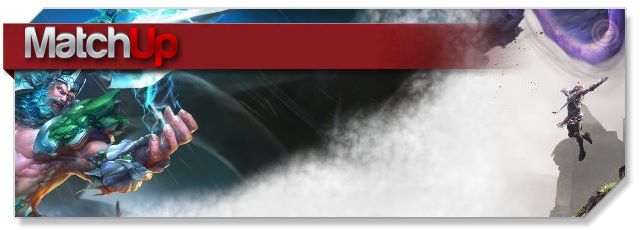Today we’re pitting SMITE from Hi-Rez Studios and Paragon from Epic Games against each other to see what each of these “third person MOBA” titles has to offer, so often are they compared we thought we’d check to see how unique they are versus how much they actually have in common.
From the outset both are free to play, this included being able to download them for free for their available platforms; Smite takes the lead here being available on PC (Windows) and PS4 with Xbox One and MacOS being added as of last year. Currently Paragon has been developed for Windows and PS4, with Epic Games stating a good relationship with Sony, and aren’t necessarily looking to introduce it to the Xbox One any time soon.
One of the things the two games does differently, insofar as being free to play, is that Paragon offers all of its hero characters for free and focuses very much on a “cosmetic and convenience” approach to microtransactions with players purchasing skins and boosters. On the flip side Smite offers a small pool of free characters to players that rotate each week giving access to different deities from their roster; to gain temporary (renting) or permanent (purchasing) access to a god players can spend earned “Favor” points by playing games and purchasing them, or through premium Gems currency that are bought with cash or earned through daily logins at the end of a week in a small amount. Every god from Smite costs 200 gems to purchase permanently, with 200 gems costing $4.99 to buy, alternatively players can purchase a bundle for $29.99 that gives them access to all the current gods and any released in the future.
With the playable characters, no doubt down to sheer amount of time between each game’s release, Smite currently stands at 86 characters versus Paragon’s 30, with Smite keeping a generous 1 new character per month and Paragon working towards 1 every 3 weeks (though we’ll see if they can keep that schedule). It will basically take around 11 years, sticking to this release schedule, for Paragon to catch up in the number of playable characters it has to be on the same pegging at Smite.
Although Paragon has a smaller roster of players, this is made up for by the high level of customization that is offered with their Deck Building elements, forgoing the use of a traditional in-game item shop purchased with gold earned in battle (seen in League of Legends, DOTA 2 and Smite), Paragon has done something a little different. Instead players will earn, purchase and craft cards that they can use to build a deck similar to a Trading Card Game, when in game they earn Card XP that they can they use to draw cards and activate up to 6 of them; with over 400 cards available this gives players a wide array of customization options to change up those 30 initial heroes. On the one hand the use of cards can be a little hard to balance as not all players have access to the same cards (unlike Smite where all players have access to all shop items), though the fact that the Card Packs are earned through in game “earn by playing” currency as opposed to being a potential pay to win premium option does make things a little more bearable.
The reason behind Pargon’s more aggressive hero release schedule and their work on the 400+ cards comes down to Smite having a lot of other stuff to focus on in terms of maps and modes; Smite has (in one way or another) ten different modes for players to play that change up the various lane numbers, players per team, mechanics and more in comparison to Paragons single 3 lane 5v5 map (which recently had a major rework with the “Monolith” release). Whilst Epic Games are planning to add new modes sooner rather than later, there’s no official schedule or details, in the meantime Hi-Rez are pushing the boundaries throwing in new “Adventure” game modes offering one unique limited time modes, such as their most recent “Apollo’s Racer Rumble” which is essentially a Smite themed version of Mario Kart complete with vehicles, weapon boxes and different tracks.
A major difference between Smite’ and Paragon’s maps is the “verticality” element, where Paragon utilizes full 3D vertical combat as seen in a third person shooter, with players able to get up onto higher ground for advantage and cover. This alone completely changes the dynamic and mechanics of combat and shows that “third person MOBA” doesn’t mean the games are alike. The map for Paragon is pretty stunning, as well as the units and heroes themselves, this is all thanks to the Unreal Engine 4 that Paragon was developed on (in comparison to Smite which uses the previous Unreal Engine 3 and offers some more cartoony graphics). Interestingly the Unreal Engine used by Hi-Rez to make their game was actually created by Epic Games!
When it comes down to it there does seem to be more that separates these two titles than makes them alike, aside from being third person MOBA (which both have a different style of third person), the mechanics, monetization, theme and available features are both extremely different from each other. Smite obviously has time on its side being out two years before Paragon went into its open beta, and so has more features, content, a healthy eSports scene, but in time we don’t doubt that will come to Paragon and both have a lot to offer and feel like completely different games.


Deja tu comentario
You must be logged in to post a comment.